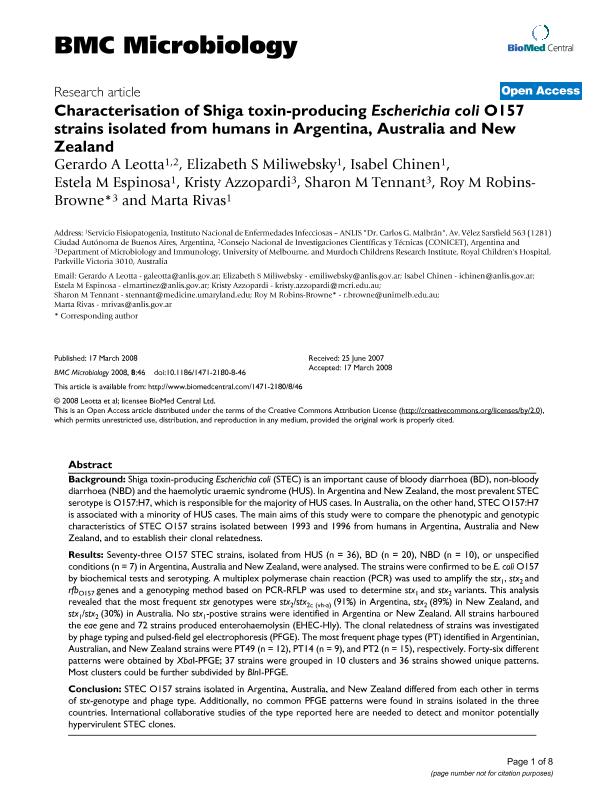Artículo
Characterisation of Shiga toxin-producing Escherichia coli O157 strains isolated from humans in Argentina, Australia and New Zealand
Leotta, Gerardo Anibal ; Miliwebsky, Elizabeth S.; Chinen, Isabel; Espinosa, Estela M.; Azzopardi, Kristy; Tennant, Sharon M.; Robins Browne, Roy M.; Rivas, Marta
; Miliwebsky, Elizabeth S.; Chinen, Isabel; Espinosa, Estela M.; Azzopardi, Kristy; Tennant, Sharon M.; Robins Browne, Roy M.; Rivas, Marta
 ; Miliwebsky, Elizabeth S.; Chinen, Isabel; Espinosa, Estela M.; Azzopardi, Kristy; Tennant, Sharon M.; Robins Browne, Roy M.; Rivas, Marta
; Miliwebsky, Elizabeth S.; Chinen, Isabel; Espinosa, Estela M.; Azzopardi, Kristy; Tennant, Sharon M.; Robins Browne, Roy M.; Rivas, Marta
Fecha de publicación:
03/2008
Editorial:
BioMed Central
Revista:
BMC Microbiology
ISSN:
1471-2180
Idioma:
Inglés
Tipo de recurso:
Artículo publicado
Resumen
Background: Shiga toxin-producing Escherichia coli (STEC) is an important cause of bloody diarrhoea (BD), non-bloody diarrhoea (NBD) and the haemolytic uraemic syndrome (HUS). In Argentina and New Zealand, the most prevalent STEC serotype is O157:H7, which is responsible for the majority of HUS cases. In Australia, on the other hand, STEC O157:H7 is associated with a minority of HUS cases. The main aims of this study were to compare the phenotypic and genotypic characteristics of STEC O157 strains isolated between 1993 and 1996 from humans in Argentina, Australia and New Zealand, and to establish their clonal relatedness. Results: Seventy-three O157 STEC strains, isolated from HUS (n = 36), BD (n = 20), NBD (n = 10), or unspecified conditions (n = 7) in Argentina, Australia and New Zealand, were analysed. The strains were confirmed to be E. coli O157 by biochemical tests and serotyping. A multiplex polymerase chain reaction (PCR) was used to amplify the stx1, stx2 and rfbO157 genes and a genotyping method based on PCR-RFLP was used to determine stx1 and stx2 variants. This analysis revealed that the most frequent stx genotypes were stx2/stx 2c (vh-a) (91%) in Argentina, stx2 (89%) in New Zealand, and stx1/stx2 (30%) in Australia. No stx 1-postive strains were identified in Argentina or New Zealand. All strains harboured the eae gene and 72 strains produced enterohaemolysin (EHEC-Hly). The clonal relatedness of strains was investigated by phage typing and pulsed-field gel electrophoresis (PFGE). The most frequent phage types (PT) identified in Argentinian, Australian, and New Zealand strains were PT49 (n = 12), PT14 (n = 9), and PT2 (n = 15), respectively. Forty-six different patterns were obtained by XbaI-PFGE; 37 strains were grouped in 10 clusters and 36 strains showed unique patterns. Most clusters could be further subdivided by BlnI-PFGE. Conclusion: STEC O157 strains isolated in Argentina, Australia, and New Zealand differed from each other in terms of stx-genotype and phage type. Additionally, no common PFGE patterns were found in strains isolated in the three countries. International collaborative studies of the type reported here are needed to detect and monitor potentially hypervirulent STEC clones.
Archivos asociados
Licencia
Identificadores
Colecciones
Articulos(IGEVET)
Articulos de INST.DE GENETICA VET ING FERNANDO NOEL DULOUT
Articulos de INST.DE GENETICA VET ING FERNANDO NOEL DULOUT
Citación
Leotta, Gerardo Anibal; Miliwebsky, Elizabeth S.; Chinen, Isabel; Espinosa, Estela M.; Azzopardi, Kristy; et al.; Characterisation of Shiga toxin-producing Escherichia coli O157 strains isolated from humans in Argentina, Australia and New Zealand; BioMed Central; BMC Microbiology; 8; 3-2008; 1-8
Compartir
Altmétricas



